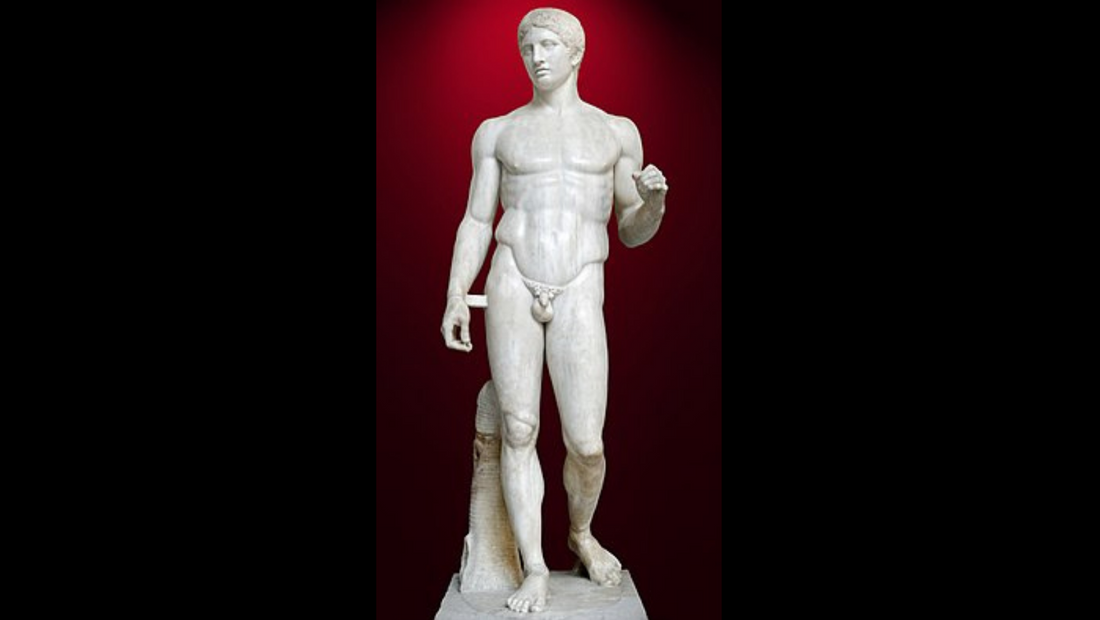Doryphoros ("spear-bearer") is the name given to a type of statue preserved in several marble copies of Roman times, the original of which goes back to a bronze statue by Polyklet, a sculptor of the 5th century BC.
The Doryphoros is central to any study of the Polykletic canon. Polyklet wrote a doctrinal treatise about it with the same name. A quotation from the canon says that the beautiful, the good, the right consists of many numbers. Thus, the canon was or included a doctrine of proportion based on measures and proportions.
It was not only ancient artists who referred to the polycletic canon. Philosophers and physicians also referred to it when they wanted to say that a principle of their own science had a general validity. The ancient sources indicate that the right measure (not too big, not too small, not too thick not too thin) was not to be gained only by numbers and not only in the body forms.
A person's posture, emotional expressions and other things can also express a right measure.
In fact, the doryphoros embodies the right measure in every sense, in the body forms as well as in the posture, which is also a mental expression. Only through this, not only through ideal body measurements, could he become the model work of Greek sculpture.
To the canon also belongs the choice of the subject, the nudity and the age of life, which shows the Doryphoros in the first years of manhood, not too young and not too old. Not one or the other half of life, but its middle is the right measure here. Age and body measurements are in a balancing middle position.
In the case of posture, on the other hand, the opposites are recorded, balancing each other out as a whole:
- Rest and movement
- tension and relaxation
- Raising and lowering
The best known expression of this play of opposites is the contrapposto. Not only the standing leg and the playing leg, but all movement motifs from head to toe are counterpoised in the doryphoros. The Doryphoros stands balanced on all sides, in perfect harmony, which is based on the balance of opposites.
With the Doryphoros, Polyklet elevated Greek art to a new world. Until then, sculpture had evolved from archaic rigidity to a free ponderation that corresponded to the natural way of standing and moving. The Doryphoros also seems to stand perfectly naturally.
At the same time, however, he embodied a law that had universal validity for the Greeks, the balance of forces or opposites, their counteracting harmony. These also correspond to principles of Greek philosophy and art, e.g. Aristotle's definition of virtue.
With the Doryphoros, Polyklet set Greek sculpture a new task, elevating it above anything it had achieved before. The Doryphoros does not only represent a lance bearer (probably Achilleus), like other statues an athlete, heros or god, whose essence they are supposed to capture, be it with the help of attributes or by their mere shape.
In him a law is realized at the same time and perfectly, which for the Greeks had the rank not only of a general law of art, but of a world principle. Besides the Doryphoros, the type of the Diadumenos or Diskophoros was groundbreaking for Greek sculpture. Later Greek sculptors such as Lysipp, Praxiteles or Skopas fell back on this.
In addition, the statue of Doryphoros was the model for the Augustus of Primaporta (1st century BC). This becomes clearest when looking at the stand. Here, too, a very clear distinction is made between the standing leg and the playing leg.

